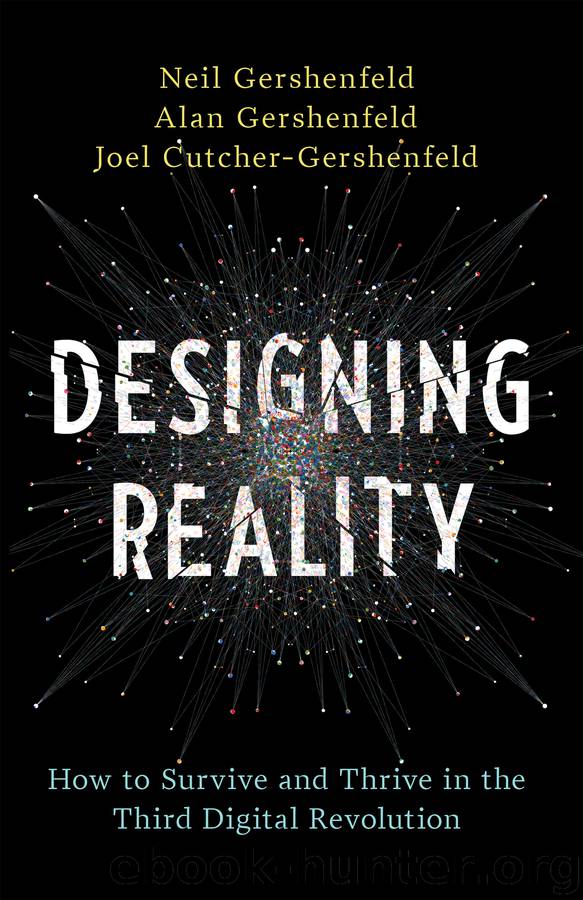Designing Reality: How to Survive and Thrive in the Third Digital Revolution by Neil Gershenfeld Alan Gershenfeld & Joel Cutcher-Gershenfeld

Author:Neil Gershenfeld, Alan Gershenfeld & Joel Cutcher-Gershenfeld
Language: eng
Format: epub
Publisher: Basic Books
Published: 2017-11-14T05:00:00+00:00
Individuals
Although some individuals such as technology pioneers and early adopters embrace and keep pace with technological change, not all individuals have this opportunity or even desire. In Future Shock, Toffler says that “too much change in too short a period of time” leads to feelings of “helplessness, despair, depression, uncertainty, insecurity, anxiety and burnout.” Many people feel this way today, a predictable response to accelerating change.
In the 1990s, a model for managing change with regard to individuals was developed for use in executive education. The transition curve depicted in the figure below illustrates how individuals respond to change. There are other similar models in use, most of which have roots in Elisabeth Kübler-Ross’s model for dealing with death and dying. In the figure, the vertical axis denotes relative levels of self-perceived competence. The horizontal axis is time. As the curve illustrates, after the initial shock of encountering something new, a person’s self-perceived competence increases with his or her denial of key aspects of the change. The process of increasing awareness and acceptance involves acknowledging what you don’t know—letting go of old assumptions, perceptions, and other considerations. Only then are experimentation, understanding, and integration possible.
What complicates the transition curve in the context of the third digital revolution is that it has to match the speed of exponential change. This requirement for speed increases the likelihood of denial after the shock and makes the journey to awareness, acceptance, experimentation, and understanding more complicated. William Bridges’s 1991 change model in Managing Transitions is consistent with the transition curve depicted in the figure above—pointing out that people have to let go of the old and navigate the “neutral zone” (awareness and acceptance) before they are ready to embrace the new. For individuals facing accelerating rates of change, it will mean managing these transitions more and more frequently.
Download
This site does not store any files on its server. We only index and link to content provided by other sites. Please contact the content providers to delete copyright contents if any and email us, we'll remove relevant links or contents immediately.
Life 3.0: Being Human in the Age of Artificial Intelligence by Tegmark Max(5404)
The Sports Rules Book by Human Kinetics(4213)
The Age of Surveillance Capitalism by Shoshana Zuboff(4117)
ACT Math For Dummies by Zegarelli Mark(3933)
Unlabel: Selling You Without Selling Out by Marc Ecko(3555)
Blood, Sweat, and Pixels by Jason Schreier(3532)
Hidden Persuasion: 33 psychological influence techniques in advertising by Marc Andrews & Matthijs van Leeuwen & Rick van Baaren(3416)
The Pixar Touch by David A. Price(3331)
Urban Outlaw by Magnus Walker(3305)
Bad Pharma by Ben Goldacre(3208)
Project Animal Farm: An Accidental Journey into the Secret World of Farming and the Truth About Our Food by Sonia Faruqi(3139)
Kitchen confidential by Anthony Bourdain(2969)
Brotopia by Emily Chang(2947)
Slugfest by Reed Tucker(2898)
The Content Trap by Bharat Anand(2837)
The Airbnb Story by Leigh Gallagher(2751)
Coffee for One by KJ Fallon(2518)
Smuggler's Cove: Exotic Cocktails, Rum, and the Cult of Tiki by Martin Cate & Rebecca Cate(2426)
Beer is proof God loves us by Charles W. Bamforth(2341)
